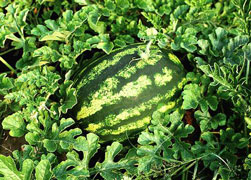


Home
Flowers &
Indoor Plants
Fruits & Nuts
Ornamentals
Vegetables
Special Topics
Resources
Glossary

|
Watermelon Citrullus lanatus (Sit-tull-us lah-nah tus) 

|
 |
What about it? Watermelons are in the gourd family along with cucumbers, melons, squashes, and pumpkins. Watermelon grows from a vine and the plant has separate male and female flowers. The fruit grows from the pollinated female flower. What is it used for? The pink flesh of this fruit is edible. Where does it grow? How do we grow it? Watermelon is a long season crop that grows best in warm temperatures. Usually, watermelon will take 3-4 months to mature. Only varieties that grow quickly should be grown in the gardens of the North. Melons need a lot of space and should be planted accordingly. To increase the soil temperature, cover the soil area with mulch; many gardeners use black plastic. What are its primary problems? The cucumber beetle is a common pest, as are mites in a dry season. Watermelons may get bacterial wilt, viruses, Alternaria leaf spot and less commonly downy mildew. How do we propagate it? Seeds may be planted directly in the garden if all danger of a frost has passed. Otherwise, sow seeds indoors 3-4 weeks before the last frost date. Seedless varieties are available. How do we harvest and store it? When a watermelon is ripe, the tendril at the point where the fruit connects to the vine will have wilted. Usually this is around 45 days after the flower has formed. The watermelon will make a dull thud when tapped, rather than a hollow sound. Store the watermelon at room temperature. They will keep for 2 weeks. Do not alter their storage temperature greatly or else they will rot.
© Copyright, Department of Horticulture, Cornell University. |